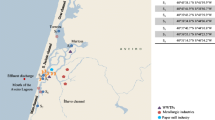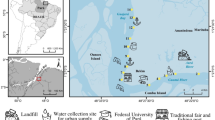Abstract
In the rapidly growing coastal megacities of developing and emerging countries, the implementation of new sewage treatment facilities is often not keeping pace with the enormous population growth, leading to a deterioration of the urban water resources. Only very few studies discuss faecal water contamination in these urban areas. Our study area Jakarta, the capital of Indonesia, is such a megacity. We investigated chemical markers of faecal contamination in water and sediments from the rivers and canals flowing through Jakarta. Moreover, also the spatial distribution of faecal markers in Jakarta Bay, the coastal ecosystem that receives all urban river discharges, was assessed. The concentrations of the faecal steroid coprostanol in river water ranged from 0.45 to 24.2 µg L−1, and in sediments from 0.3 to 400 µg g−1, reflecting the problem of inadequate sewage treatment capacities in the city. The steroid distribution in Jakarta Bay in May 2013 as compared to dry season data indicates a flushing out of particle-associated pollutants from the urban rivers far offshore during the precedent rainy season, where the city experienced a severe flood. This flushing out of particle-associated pollutants during times of heavy rainfall as observed in our study is a pollutant transport mechanism that is important for all tropical coastal systems. The associated impacts on sensitive coastal habitats might become more severe in the future, as a consequence of the expected climate change effects on monsoon variability.



Similar content being viewed by others
References
Brown RC, Wade TL (1984) Sedimentary coprostanol and hydrocarbon distribution adjacent to a sewage outfall. Water Res 18:621–632. doi:10.1016/0043-1354(84)90213-6
Carreira RS, Wagener AL, Readman JW (2004) Sterols as markers of sewage contamination in a tropical urban estuary (Guanabara Bay, Brazil): space–time variations. Estuar Coast Shelf S 60:587–598. doi:10.1016/j.ecss.2004.02.014
Cordeiro LG, Carreira RS, Wagener AL (2008) Geochemistry of faecal sterols in a contaminated estuary in southeastern Brazil. Org Geochem 39:1097–1103. doi:10.1016/j.orggeochem.2008.02.022
Cybriwsky R, Ford LR (2001) City profile: Jakarta. Cities 18:199–210. doi:10.1016/S0264-2751(01)00004-X
Dsikowitzky L, Schwarzbauer J, Littke R (2002) Distribution of polycyclic musks in water and particulate matter of the Lippe River (Germany). Org Geochem 33:1747–1758. doi:10.1016/S0146-6380(02)00115-8
Furtula V, Liu J, Chambers P, Osachoff H et al (2012) Sewage treatment plants efficiencies in removal of sterols and sterol ratios as indicators of faecal contamination sources. Water Air Soil Poll 223:1017–1031. doi:10.1007/s11270-011-0920-8
Grimalt JO, Fernandez P, Bayona JM, Albaiges J (1990) Assessment of fecal sterols and ketones as indicators of urban sewage inputs to coastal waters. Environ Sci Technol 24:357–363. doi:10.1021/es00073a011
Isobe KO, Tarao M, Zakaria MP et al (2002) Quantitative application of faecal sterols using gas chromatography—mass spectrometry to investigate faecal pollution in tropical waters: Western Malaysia and Mekong Delta, Vietnam. Environ Sci Technol 36:4497–4507. doi:10.1021/es020556h
Leeming R, Ball A, Ashbolt N, Nichols P (1996) Using faecal sterols from humans and animals to distinguish faecal pollution in receiving waters. Water Res 30:2893–2900. doi:10.1016/S0043-1354(96)00011-5
Nichols PD, Leeming R, Rayner MS et al (1993) Comparison of the abundance of the faecal sterol coprostanol and faecal bacterial groups in inner-shelf waters and sediments near Sydney, Australia. J Chromatogr A 643:189–195. doi:10.1016/0021-9673(93)80552-J
Peng X, Zhang G, Mai B et al (2005) Tracing anthropogenic contamination in the Pearl River estuarine and marine environment of South China Sea using sterols and other organic molecular markers. Mar Pollut Bull 50:856–865. doi:10.1016/j.marpolbul.2005.02.031
Phanuwan C, Takizawa S, Oguma K et al (2006) Monitoring of human enteric viruses and coliform bacteria in waters after urban flood in Jakarta, Indonesia. Water Sci Technol 54(3):203–210. doi:10.2166/wst.2006.470
Quéméneur M, Marty Y (1994) Fatty acids and sterols in domestic wastewaters. Water Res 28:1217–1226. doi:10.1016/0043-1354(94)90210-0
Schwarzbauer J, Littke R, Weigelt V (2000) Identification of specific organic contaminants for estimating the contribution of the Elbe river to the pollution of the German Bight. Organic Geochem 31:1713–1731. doi:10.1016/S0146-6380(00)00076-0
Suwandana E, Kawamura K, Tanaka K et al (2011) Escherichia coli and biophysicochemical relationships of seawater and water pollution index in the Jakarta Bay. Am J Environ Sci 7(3): 183–194, ISSN 1553-345X
Takada H, Eganhouse RP (1998) Molecular markers of anthropogenic waste. In: Meyers RA (ed) Encyclopedia of environmental analyses and remediation. Wiley, New York, pp. 2883–2940. ISBN 0-471-11708-0
UN-Habitat, United Nations Human Settlements Programme (2009) Planning sustainable cities: global report on human settlements 2009. Nairobi, Kenya, p. 306, ISBN:978-18-4-407899-8
Acknowledgements
This study is part of the Indonesian-German SPICE Program (Science for the Protection of Indonesian Coastal Marine Ecosystems), funded by the BMBF (Grant 03F0641E) and supported institutionally by BBP4BKP.
Author information
Authors and Affiliations
Corresponding author
Rights and permissions
About this article
Cite this article
Dsikowitzky, L., Schäfer, L., Dwiyitno et al. Evidence of massive river pollution in the tropical megacity Jakarta as indicated by faecal steroid occurrence and the seasonal flushing out into the coastal ecosystem. Environ Chem Lett 15, 703–708 (2017). https://doi.org/10.1007/s10311-017-0641-3
Received:
Accepted:
Published:
Issue Date:
DOI: https://doi.org/10.1007/s10311-017-0641-3




